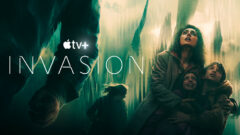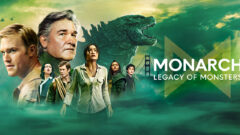Ridley Scott’s feature film Napoleon chronicles the epic rise and life of Napoleon Bonaparte. Working closely with VFX Supervisor Charley Henley, The Third Floor created postvis for the Battle of Waterloo to help the filmmakers map out digital extensions of the armies to the practical photography.
The production cinematography filmed for The Battle of Waterloo in the movie depicts two practical sets, with the French and British encampments staged on opposing hillsides separated by a kilometer of distance. TTF’s postvis team visualized digital set extensions to both of these camps, depicting the filmed plates to include thousands of tents, ammunition dumps, cannons, flags, soldiers and small campfires. These arrangements helped to illustrate the sheer scale of both armies, filling the horizons of the filmed plates and informing the filmmakers of the quantity and density of these features for the final VFX.
As the story unfolds and the armies prepare for battle, Napoleon and the Duke of Wellington view each other’s camps through their telescopes. Visualization Supervisor Martin Chamney states: “We were asked to create postvis versions of the shots using the filmed plates in which the size of the French army dispatching from their camp was extended in two waves of lines of soldiers. The incredible real-life photography follows hundreds of soldiers (extras) marching in formation across the valley. One of the most important aspects to the postvis was to visualize the arrangement of armies marching or attacking in precise numbers and specific formations. We extended the lines of photographed troops with CG soldiers across several postvis shots using a custom crowd system. A library of animation cycles was created for all the required actions of the soldiers – marching, attacking, firing, and dying. The crowd system enabled us to increase the number of soldiers and visualize the historical scale of the French army.”

As the action continues, the sequence shows the strategic height advantage the British army has as it begins to deplete the lines of approaching French soldiers with cannon and musket fire.
“The British army’s ingenuity is shown as the real-life soldiers maneuver in highly effective defensive squares against the attacking French cavalry,” Chamney describes. “Postvis composites were created visualizing how both the numbers of British soldiers and the lines of French cavalry circling the squares could be digitally extended.” For wide vistas of the arriving Prussian army, TTF extended the number of soldiers from the hundreds of extras that were filmed on set up to 45,000 soldiers, illustrating in postvis the scale of the event in these shots prior to completion of final comps by the VFX team.
Closing scenes, where the final visuals depict thousands of soldiers fighting with guns and swords at close quarters in a huge grisly massacre, were also visualized in postvis to inform the final CG staging extensions and effects.

In one iconic beat, Napoleon rides into a courtyard where his horse is killed by cannon fire. Working with photography of a practical horse model mounted to a gimbal filmed on a bluescreen stage, TTF appended CG legs to the collapsing injured horse and composited the plate and digital elements together to create a stand-in for the shot in postvis that reflected the filmmaker’s composition and vision.








